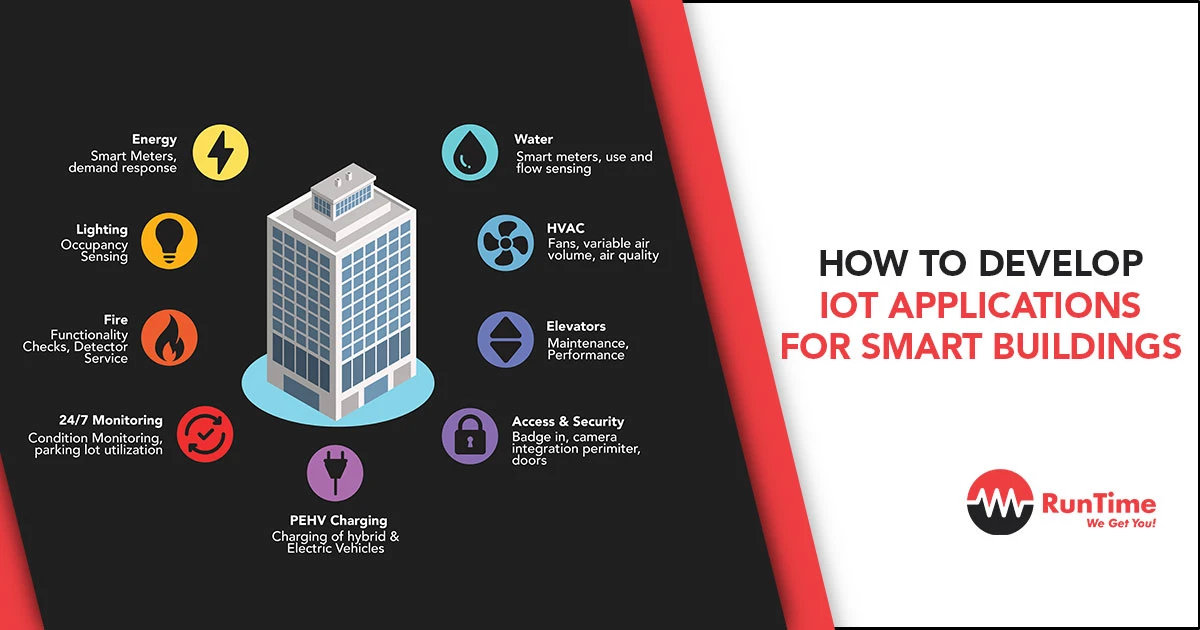The advent of the Internet of Things (IoT) has brought about a transformative shift in the realm of smart buildings, promising unprecedented levels of operational efficiency, sustainability, and occupant comfort. However, the path to realizing these benefits through IoT applications is intricate, demanding a deep understanding of both the technical and conceptual facets of smart buildings. Let’s discuss developing IoT applications for smart buildings, including innovative practices, technical challenges, and analytical strategies for industry professionals.
Understanding the Ecosystem of Smart Buildings
The foundation of smart buildings lies in their ability to seamlessly integrate diverse systems—ranging from HVAC and lighting to security and energy management—through interconnected IoT devices. This integration is facilitated by a vast array of sensors and actuators that collect data on various parameters, such as temperature, humidity, occupancy, and energy consumption. The essence of a smart building’s ecosystem is its networked nature, allowing for real-time monitoring, predictive maintenance, and automated control systems that adapt to both environmental conditions and occupant preferences. At its core, this ecosystem comprises several layers:
- Sensing Layer: This layer includes a wide range of sensors (temperature, humidity, CO2 levels, occupancy, light, and more) that collect real-time data from the environment. Actuators play a pivotal role here by executing actions based on commands from the control system, such as adjusting lighting, temperature, or even window shades.
- Connectivity Layer: This layer ensures that data collected by sensors and actuators can be transmitted to a central system for analysis. It encompasses the network infrastructure, including routers, gateways, and data aggregation points, facilitating both wired and wireless communication within the building.
- Data Processing Layer: Here, the raw data is transformed into actionable insights. This involves complex data analytics, machine learning algorithms for predictive modeling, and decision-making processes that enable the automated adjustment of building operations.
- Application Layer: The final layer focuses on delivering user-centric services and interfaces. These applications enable facility managers to monitor and control building systems efficiently, while providing occupants with personalized environments.
Identifying the Building Blocks
Hardware Selection
The choice of hardware is critical in the IoT development process, involving sensors for data acquisition, actuators for control, and gateways for data aggregation and transmission. Key considerations include:
- Durability and Reliability: Devices must withstand environmental conditions and provide consistent performance.
- Scalability: Hardware should easily integrate into existing systems and be capable of expansion to accommodate future growth.
- Energy Efficiency: Low-power devices extend battery life and reduce maintenance needs, crucial for large-scale deployments.
Software Platforms
On the software front, developers require platforms that can handle vast data streams, analyze this data for actionable insights, and facilitate interaction between users and the system. Essential features include:
- Data Processing Capabilities: Ability to process and analyze data in real-time, employing machine learning for predictive analytics.
- User Interface Design: Development of intuitive interfaces that cater to various user groups, from facility managers to occupants.
- Integration Flexibility: Support for integration with third-party applications and systems, ensuring a cohesive ecosystem.
Leveraging Connectivity Protocols
Effective communication between devices is paramount. Protocols like MQTT and CoAP are favored for their efficiency in data transmission, particularly in bandwidth-constrained environments. The transition to IPv6 addresses the need for a vast address space, accommodating the exponential growth in IoT devices. The choice of connectivity protocols extends to:
- Wireless Standards: Zigbee, Z-Wave, Wi-Fi, and Bluetooth offer options for different use cases, balancing range, bandwidth, and power consumption.
- Wired Connectivity: Ethernet and Power over Ethernet (PoE) provide reliable, high-speed connections for critical infrastructure components.
Prioritizing Security and Privacy
Security is a multi-layered concern, encompassing device security, data encryption, and user authentication. Best practices include:
- End-to-End Encryption: Ensuring data is encrypted from the point of collection to storage and analysis.
- Access Control: Implementing robust authentication mechanisms to prevent unauthorized access.
- Compliance: Adhering to regulations like GDPR to protect user data and privacy.
- Regular Updates and Patch Management: Ensuring that firmware and software are regularly updated to address new security vulnerabilities.
- Data Anonymization: Techniques to ensure that data cannot be traced back to individual users, enhancing privacy protection.
Embracing Cloud and Edge Computing
The synergy between cloud and edge computing offers a balanced approach to data management. While the cloud provides scalable storage and processing capabilities, edge computing brings processing closer to the data source, reducing latency and bandwidth use, especially crucial for real-time applications.
- Data Sovereignty: Local processing of sensitive data can address legal and regulatory requirements by keeping data within geographical or jurisdictional boundaries.
- Scalable AI: Cloud resources can be leveraged for training AI models, which are then deployed at the edge for real-time decision-making.
Implementing User-centric Design
The success of IoT applications in smart buildings ultimately depends on their acceptance and use by occupants. A user-centric design approach ensures that applications are intuitive, responsive, and tailored to meet the diverse needs and preferences of users. User-centric design in smart buildings encompasses:
- Accessibility: Ensuring that interfaces are accessible to users with different abilities, incorporating voice commands, touch interfaces, and visual cues.
- Customization: Allowing users to customize settings according to their preferences, thereby enhancing the user experience and satisfaction.
Navigating Challenges and Opportunities
Developers face numerous challenges, including device interoperability, data privacy concerns, and the technical complexities of system integration. Yet, these challenges also present opportunities for innovation—leveraging AI for smarter predictive maintenance, exploring sustainable energy solutions, and enhancing user well-being through personalized environmental controls. As developers navigate these challenges, they encounter opportunities to:
- Integrate Renewable Energy Sources: Smart building IoT applications can optimize the use of solar panels and battery storage, contributing to energy sustainability.
- Enhance Indoor Environmental Quality (IEQ): Leveraging IoT for monitoring and controlling air quality, lighting, and acoustics to improve occupant health and productivity.
Final Word
The development of IoT applications for smart buildings is a complex, multifaceted endeavor that requires a comprehensive understanding of both the technological and conceptual aspects of smart buildings. By focusing on the right hardware and software, prioritizing security and privacy, leveraging the latest in connectivity and computing technologies, and placing the user at the center of design efforts, developers can overcome challenges and tap into the vast potential of smart buildings. As this field continues to evolve, the insights and strategies discussed herein will serve as valuable resources for those seeking to innovate and excel in the development of IoT applications for smart buildings.
Hire Control Systems Engineers with RunTime
At RunTime, we are dedicated to helping you find the best Control Systems Engineering talent for your recruitment needs. Our team consists of engineers-turned-recruiters who have an extensive network and a focus on quality. By partnering with us, you will have access to great engineering talent that drives innovation and excellence in your projects.
Discover how RunTime has helped 423+ tech companies find highly qualified and talented engineers to enhance their team’s capabilities and achieve strategic goals.
On the other hand, if you’re a control systems engineer looking for new opportunities, RunTime Recruitment’s job site is the perfect place to find job vacancies.









